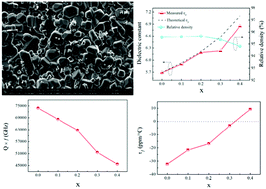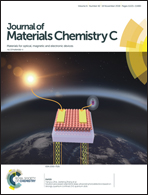Novel Al2Mo3O12-based temperature-stable microwave dielectric ceramics for LTCC applications†
Abstract
Microwave dielectric ceramics are key materials in low-temperature co-fired ceramic (LTCC) technology. In many material systems, Mo-based microwave dielectric ceramics have attracted world-wide attention in recent years due to their low intrinsic sintering temperature and high quality factor (Q × f). In combination with its low dielectric constant (εr), Al2Mo3O12 is a very promising LTCC candidate, but the very negative temperature coefficient of its resonant frequency (τf) limits its application. In this work, novel (1 − x)Al2Mo3O12–xTiO2 (x = 0–0.4) microwave dielectric ceramics were designed and prepared by a conventional solid-state reaction. The effects of TiO2 addition on the phase composition, microstructure, and microwave dielectric properties of the obtained Al2Mo3O12-based ceramics were investigated. It was revealed that rutile TiO2 could co-exist with monoclinic Al2Mo3O12 in the samples after they were prepared under optimized conditions. With increasing addition of TiO2, the εr value of the obtained ceramics increased from 5.69 to 6.85, the value of Q × f decreased from 73 910 to 45 720 GHz, and τf varied from −32.3 to +9.2 ppm °C−1. When x = 0.3, microwave dielectric ceramics of near-zero τf (εr = 6.23, Q × f = 51 630 GHz, and τf = −3.3 ppm °C−1) could be obtained. Such high-performance microwave dielectric ceramics would be promising for LTCC applications.



 Please wait while we load your content...
Please wait while we load your content...